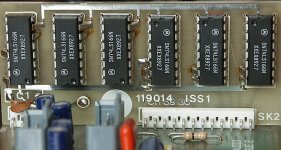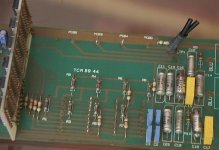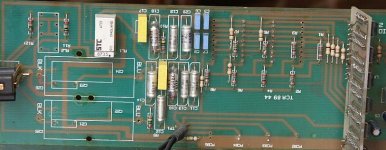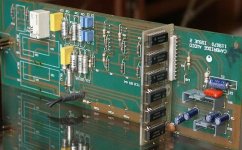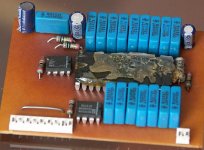pilli said:Very interesting.
So work's not finished yet.
Now, what I have is actually not a "CD3" but a "DAC3". I always thought that the interiors were the same, but evidently they are not.
(This DAC3 is actually a strange bird, because Cambridge also made a DAC3 with a very similar box, but not quite the same, that had a double TDA1305 converter...)
Here's the picture of the card that I copied:
Hello Pilli
I've found out that there is two line of Cambridge Audio product, because some was design before Cambridge Audio was buy by another company. So you have the real DAC3 made by the original Cambridge Audio.
Gaetan
Thanks for the clean schematic!
One connection was missing in my posts 23, 24: pin1 of IC6 to the lonesome inverter, pin13 of IC1F.
Also check the other additions from post 25.
I'll have a look at the real thing , but wouldn't it be logic to think that the input to the inverter is BCK (buffered and redistributed); the input to the "A" flip-flop is Word-Select (straight out to DAC-I, shifted/inverted to the other DACs); and the input to the "B" flip-flop is Data (straight out to DAC1 and shifted more and more to the other DACs)?
, but wouldn't it be logic to think that the input to the inverter is BCK (buffered and redistributed); the input to the "A" flip-flop is Word-Select (straight out to DAC-I, shifted/inverted to the other DACs); and the input to the "B" flip-flop is Data (straight out to DAC1 and shifted more and more to the other DACs)?
I can definitely do better pictures than the ones I posted.
But not the back of the cards, which is not accessible unless they are desoldered, which I'm not going to do
I can clean up the sketches I made by hand, which will give an idea of the physical routing. It's just gonna be slow, because I was currently busy on things quite away from digital (a tube amplifier for my Stax headphones )
)
Will you give us the .sch files?
_
One connection was missing in my posts 23, 24: pin1 of IC6 to the lonesome inverter, pin13 of IC1F.
Also check the other additions from post 25.
aparatusonitus said:(...) how I2S lines from SAA7220 are connected to pin # 1 of SN74LS04N (IC1A) and pins # 2 & 12 of SN74LS74N (IC2A/B).
I'll have a look at the real thing
 , but wouldn't it be logic to think that the input to the inverter is BCK (buffered and redistributed); the input to the "A" flip-flop is Word-Select (straight out to DAC-I, shifted/inverted to the other DACs); and the input to the "B" flip-flop is Data (straight out to DAC1 and shifted more and more to the other DACs)?
, but wouldn't it be logic to think that the input to the inverter is BCK (buffered and redistributed); the input to the "A" flip-flop is Word-Select (straight out to DAC-I, shifted/inverted to the other DACs); and the input to the "B" flip-flop is Data (straight out to DAC1 and shifted more and more to the other DACs)?aparatusonitus said:
Now, I need a high resolution top and bottom image of the TTL and DAC boards as well as dimension of boards to produce exact copy (how inventing of me😀).
I can definitely do better pictures than the ones I posted.
But not the back of the cards, which is not accessible unless they are desoldered, which I'm not going to do

I can clean up the sketches I made by hand, which will give an idea of the physical routing. It's just gonna be slow, because I was currently busy on things quite away from digital (a tube amplifier for my Stax headphones
 )
)Will you give us the .sch files?
_
gaetan8888 said:
I would do a tube passive I/V and output and low pass filter, like the Leicha Bogdanov DAC or the mr. Leach Adagio DAC. Or maby a cathode follower type. But no oversampling, so the filter would be done for the 4x analog shifted register upsampling. So it use a CS8412 or CS8414 receiver chip.
Hi Gaetan,
I'm not sure I understand your plan exactly. Sorry, I don't master I2S enough to be able to help. But make sure that the timing implemented in the Cambridge Audio solution is still correct in your case.
Would you still have four TDA1541's?
Of course I/V is performed on AOR/AOL of each TDA1541, so you'd have eight resistors, and probably each one would need its own tube(s).
But of course I do not want to discourage you fom experimenting

_
pilli said:
Hi Gaetan,
I'm not sure I understand your plan exactly. Sorry, I don't master I2S enough to be able to help. But make sure that the timing implemented in the Cambridge Audio solution is still correct in your case.
Would you still have four TDA1541's?
Of course I/V is performed on AOR/AOL of each TDA1541, so you'd have eight resistors, and probably each one would need its own tube(s).
But of course I do not want to discourage you fom experimenting
_
Hello Pilli
Yes, I will use four TDA1541's, so each one would need its own tube(s).
For the I2S, is it not that type of input for the DAC3 ?
And they don't made the SAA7210 anymore, so I will have no choice to use a Cs8414 chip.
Thank
Gaetan
gaetan8888 said:And they don't made the SAA7210 anymore, so I will have no choice to use a Cs8414 chip.
You do have a choice, use WM8804 from Wolfson Microelectronics which will give you far better jitter performance (less then 50ps as was modestly stated in datasheet, if implemented correctly of course).😉
gaetan8888 said:
For the I2S, is it not that type of input for the DAC3 ?
And they don't made the SAA7210 anymore, so I will have no choice to use a Cs8414 chip.
The DAC3 has an SPDIF input.
SPDIF receiver is Sony CX23053.
I've never been able to find a datasheet of this, but I deduced that this chip translates the incoming stream to I2S that goes to an SAA7220 (not 7210).
The SAA7220 performs 4x oversampling and sends the resulting I2S to the TTL card that we've been describing here.
These TTL chips split that *oversampled* I2S in four differently shifted "copies", for each of the four DAC chips (TDA1541).
The four analog outputs (per channel) resulting from the TDA1541's are then converted to voltage (by OpAmps 5334) and simply "superposed", without any buffer/amplifier. And some low pass filter (a parallel cap) is applied to this. The last thing is the output-coupling through the big 5uF caps.
Indeed you can do with any CS84xx SPDIF receiver, and even any oversampling filter different from SAA7220, as long as it can output I2S in the Philips "flavour".
What I was wondering about was whether this approach by Cambridge is the easiest way to do non-OS "mulitple" DACs, since it seems to me more like "more-oversampling", obtained in a clever way...
_
pilli said:One connection was missing in my posts 23, 24: pin1 of IC6 to the lonesome inverter, pin13 of IC1F.
Also check the other additions from post 25.
OK, I've updated sch to recent correction.
pilli said:I'll have a look at the real thing, but wouldn't it be logic to think that the input to the inverter is BCK (buffered and redistributed); the input to the "A" flip-flop is Word-Select (straight out to DAC-I, shifted/inverted to the other DACs); and the input to the "B" flip-flop is Data (straight out to DAC1 and shifted more and more to the other DACs)?
Output from SAA7220 is wired now as per yours sugestion. Please, just check with DVM real thing to be sure.
pilli said:I can definitely do better pictures than the ones I posted.
But not the back of the cards, which is not accessible unless they are desoldered, which I'm not going to do
I can clean up the sketches I made by hand, which will give an idea of the physical routing. It's just gonna be slow, because I was currently busy on things quite away from digital (a tube amplifier for my Stax headphones)
If you put some light (a lamp) from the back of the TTL board, trases will be more visible from front of it, so you can take a picture and/or take a sketch by hand.
pilli said:Will you give us the .sch files?
Of course, see below...
Attachments
aparatusonitus said:
Output from SAA7220 is wired now as per yours sugestion. Please, just check with DVM real thing to be sure.
I've checked the connections from the receiver/oversampling card of the DAC3, and hey! that was correct, I'm very proud 🙂
So:
Pin 1 of the 7404 has BCK
Pin 2 of 7474 has WS
Pin 12 of 7474 has Data
Sorry that it comes so slow, but as I said, my table is full of parts for building a +250V -350V supply to tubes, and 580V for biasing those electrostatics
 .
.If everything goes well, I'll dig out the Cambridge again next thing, especially to A-B-compare it with a passive I/V + tubes TDA1541A (implanted on a cheapo Marantz CD65, my current "playing" player, that beats two fatso Japanese "boutique-wannabes" - an 8xPCM1702, quite a decent performer I must say, and a dual AD1862 from Denon, frustrated by its too many OpAmps of an insufficient quality, and a 78/7912 supply, that much for a "Gold Edition"
 )
)You guys will even jump your priority above my planned SACD experiments. Just not this week.
_
Hi pilli,
Thank you for checking out I2S bus lines, good work. Please, take you time, no hurry...
BTW, that player of yours with 8 x PCM1702, is it a Denon DCD-3000 or Kenwood DP-7090? I'm asking this because I have DCD-3000, but the sound...err is just sound, no music at all...and as you rightly noticed, those low quality opamps are to blame. Some of them are duals, but only one side is in use, go figure...
Thank you for checking out I2S bus lines, good work. Please, take you time, no hurry...
BTW, that player of yours with 8 x PCM1702, is it a Denon DCD-3000 or Kenwood DP-7090? I'm asking this because I have DCD-3000, but the sound...err is just sound, no music at all...and as you rightly noticed, those low quality opamps are to blame. Some of them are duals, but only one side is in use, go figure...
(out of the Cambridge topic)
Hi aparatusonitos,
It is a Kenwood 7090, completely original.
(I need to keep one usable to "madame"; she notices and appreciates improvements in the sound, but using a screwdriver to "press play" is just too much...)
It seems like this player has quite good power supplies, and a decent output stage (two stages of 4580 opamps, one I/V, one to sum balanced DACs). Will be easy to try better OpAmps, or a discrete balanced-to-SE, or even discrete I/V.
As I said, seems like a good performer to me (what is always strange is the sensation of "space", of the scene, that it gives to me; hard to describe, not unpleasant at all, but as if made of "terracotta", or teak wood. Am I influenced by having read BB chips described as "brown"? just magazine bs? boh!)
The Denon I was mentioning is a 1650GR, where the GR stands for "Gold Whatzoever".
I think it's a Japan-only edition of our 1560, or 2560. It has dual (balanced) AD1862 per channel, and I've read good things of that DAC on this forum, so when I had a chance I bought this heavy box.
But music gets lost somewhere. Here there's I/V, then Sum, then a "GIC" filter, then an output buffer. Four stages of OpAmps and not of the best... (4558 and BA15218, if I remember well).
and not of the best... (4558 and BA15218, if I remember well).
And one brave 7812/7912, shared between all those OpAmps and the DACs too.
We'll take care of him one day, I just don't trust my mods enough yet to make them on a box that cost me 100+ Euros
So many things to try!!
("Madame" - that's how the French refer to "wife" - thinks that I should just go and buy what could sound good, we could afford something good enough, but hey! that's no fun! I mean, it is "only" listening fun...)
(And you know what?
I live at one hour by car from Jadis and one and a half from Metronome Technology... I even visited Metronome's demo room...)
_
aparatusonitus said:
BTW, that player of yours with 8 x PCM1702, is it a Denon DCD-3000 or Kenwood DP-7090?
Hi aparatusonitos,
It is a Kenwood 7090, completely original.
(I need to keep one usable to "madame"; she notices and appreciates improvements in the sound, but using a screwdriver to "press play" is just too much...)
It seems like this player has quite good power supplies, and a decent output stage (two stages of 4580 opamps, one I/V, one to sum balanced DACs). Will be easy to try better OpAmps, or a discrete balanced-to-SE, or even discrete I/V.
As I said, seems like a good performer to me (what is always strange is the sensation of "space", of the scene, that it gives to me; hard to describe, not unpleasant at all, but as if made of "terracotta", or teak wood. Am I influenced by having read BB chips described as "brown"? just magazine bs? boh!)
The Denon I was mentioning is a 1650GR, where the GR stands for "Gold Whatzoever".
I think it's a Japan-only edition of our 1560, or 2560. It has dual (balanced) AD1862 per channel, and I've read good things of that DAC on this forum, so when I had a chance I bought this heavy box.
But music gets lost somewhere. Here there's I/V, then Sum, then a "GIC" filter, then an output buffer. Four stages of OpAmps
 and not of the best... (4558 and BA15218, if I remember well).
and not of the best... (4558 and BA15218, if I remember well).And one brave 7812/7912, shared between all those OpAmps and the DACs too.
We'll take care of him one day, I just don't trust my mods enough yet to make them on a box that cost me 100+ Euros

So many things to try!!
("Madame" - that's how the French refer to "wife" - thinks that I should just go and buy what could sound good, we could afford something good enough, but hey! that's no fun! I mean, it is "only" listening fun...)
(And you know what?
I live at one hour by car from Jadis and one and a half from Metronome Technology... I even visited Metronome's demo room...)
_
pilli said:It is a Kenwood 7090, completely original.
(I need to keep one usable to "madame"; she notices and appreciates improvements in the sound, but using a screwdriver to "press play" is just too much...)
I would keep that player (at least to please "madame")...and you can always buy cheap universal remote control to operate from distance, if you have manage to lost/destroyed the original one.
pilli said:It seems like this player has quite good power supplies, and a decent output stage (two stages of 4580 opamps, one I/V, one to sum balanced DACs). Will be easy to try better OpAmps, or a discrete balanced-to-SE, or even discrete I/V.
Try good opamps, and if you get really BIG improvements, if I were you, I would go discrete, all the way.
pilli said:The Denon I was mentioning is a 1650GR, where the GR stands for "Gold Whatzoever".
I think it's a Japan-only edition of our 1560, or 2560. It has dual (balanced) AD1862 per channel, and I've read good things of that DAC on this forum, so when I had a chance I bought this heavy box.
But music gets lost somewhere. Here there's I/V, then Sum, then a "GIC" filter, then an output buffer. Four stages of OpAmpsand not of the best... (4558 and BA15218, if I remember well).
And one brave 7812/7912, shared between all those OpAmps and the DACs too.
We'll take care of him one day, I just don't trust my mods enough yet to make them on a box that cost me 100+ Euros
As with Kenwood, try different HQ opamps, then go discrete. For I/V stage, you should build a zero global negative feedback circuit, like current conveyor, than buffers like Wadia used to with PA630 chip which is obsolete now, pity.
pilli said:("Madame" - that's how the French refer to "wife" - thinks that I should just go and buy what could sound good, we could afford something good enough, but hey! that's no fun! I mean, it is "only" listening fun...)
I second that!
pilli said:(And you know what?
I live at one hour by car from Jadis and one and a half from Metronome Technology... I even visited Metronome's demo room...)
It seems that south of France is audiophile/technofile friendly place.
- Status
- Not open for further replies.
- Home
- Source & Line
- Digital Source
- Need schematic for a Cambridge Audio CD3 cd Player
